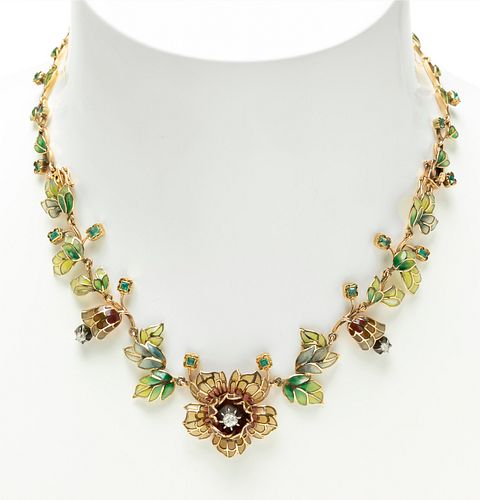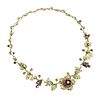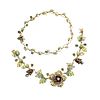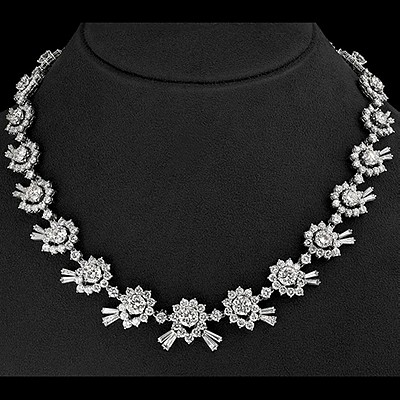Necklace MASRIERA AND CARRERAS in 18kt yellow gold, emeralds, diamonds and enamels "plique-à-jour".
Lot 70
About Seller
Setdart Auction House
Carrer Aragó 346
Barcelona
Spain
Setdart Subastas was born in 2004 and is currently the first online art auction in Spain with solidity, prestige and reliability guaranteed by our more than 60,000 users. Setdart has a young, dynamic and enterprising team ready to successfully manage the purchase and sale of art works through custom...Read more
Categories
Estimate:
EUR€9,000 - EUR€10,000
$9,375 - $10,416.67
Absentee vs Live bid
Two ways to bid:
- Leave a max absentee bid and the platform will bid on your behalf up to your maximum bid during the live auction.
- Bid live during the auction and your bids will be submitted real-time to the auctioneer.
Bid Increments
| Price | Bid Increment |
|---|---|
| EUR€0 | EUR€10 |
| EUR€200 | EUR€25 |
| EUR€500 | EUR€50 |
| EUR€1,000 | EUR€100 |
| EUR€3,000 | EUR€200 |
| EUR€5,000 | EUR€500 |
| EUR€10,000 | EUR€1,000 |
| EUR€20,000 | EUR€2,000 |
| EUR€50,000 | EUR€5,000 |
About Auction
By Setdart Auction House
Jun 28, 2021
Set Reminder
2021-06-28 07:00:00
2021-06-28 07:00:00
America/New_York
Bidsquare
Bidsquare : Numismatics, Jewelry and Watches
https://www.bidsquare.com/auctions/setdart-auction-house/numismatics-jewelry-and-watches-7133
Setdart Auction House sofia@setdart.com
Setdart Auction House sofia@setdart.com
- Lot Description
Necklace MASRIERA AND CARRERAS in 18kt yellow gold, emeralds, diamonds and enamels "plique-à-jour". It is a detachable model convertible into a bracelet. Measures: 3 cm (central flower); 12 cm (diameter). Inspired by the floral world, this necklace alternates the decorativeness of plique-à-jour enamels with the beauty of emeralds and the subtlety of old brilliant-cut diamonds. It has a drawer clasp with a tab, a pusher and a safety catch. It comes with its original Masriera and Carreras case. The plique-à-jour technique, French for "letting the light in", is a vitreous enameling technique in which the enamel is applied in cells, similar to cloisonné, but without any backing material on the finished product, so that light can pass through the transparent or translucent material. It is an extremely expensive technique (up to 4 months to produce a piece), with a high failure rate. The silverware and jewelry firm was founded in Barcelona in 1839 by Josep Masriera Vidal. The process of making the pieces, from design to the final polishing, was carried out in the family workshop, which was expanded as demand increased and, with it, production. At the end of the 19th century, the Masriera workshop was already the most important in the city of Barcelona, obtaining the Gold Medal and the Unique Prize awarded by the Associació d'Artífexs en Joieria i Plateria de Barcelona. In 1887 the firm was renamed Masriera y Hermanos, with Josep Masriera Manovens at the helm. At this time the production was extended to jewelry, partly thanks to the recovery of various techniques of enamel processing, and Lluís Masriera Rosés, Josep's son, became the jeweler of Catalan modernism, achieving international renown. In the second decade of the 20th century, the firm left behind the Art Nouveau style in favor of more geometric lines, close to the new Art Deco. In the middle of Noucentisme, in 1915, two of the oldest families of silversmiths and jewelers in Catalonia, the Masriera and Carreras, who had been in business since 1766, merged thanks to the association of Masriera and his brothers with Joaquim Carreras Nolla. The firm Masriera y Carreras was born, focused on the production of Lluís Masriera's designs and the new and booming European Art Deco style. Their participation in the International Exhibition of Modern Decorative and Industrial Arts in Paris in 1925, and in the Universal Exhibition in Barcelona in 1929, meant the definitive international recognition of the firm. In 1985 Masriera y Carreras and Bagués, another of Barcelona's historic firms, joined forces. The Bagués-Masriera firm remains active to this day.
- Shipping Info
-
In-house shipping available. Please inquire at admin@setdart.com.
-
- Buyer's Premium



 EUR
EUR CAD
CAD AUD
AUD GBP
GBP MXN
MXN HKD
HKD CNY
CNY MYR
MYR SEK
SEK SGD
SGD CHF
CHF THB
THB
















